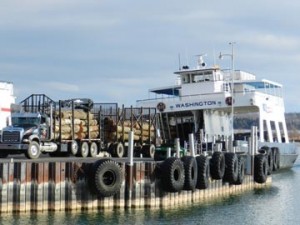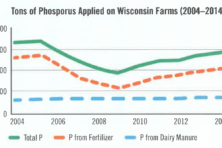Low Water Hits Island Hard
- Share
- Tweet
- Pin
- Share

Detroit Harbor looked like this in October, before the lake dropped another 10 inches or so and winter began. Photo by Richard Purinton.
What do low lake levels mean for an island community dependent on regular and consistent ferry service?
It’s one thing to see unpleasant stretches of exposed mud and rocks along shore, perhaps accompanied by marine smells in the heat of summer. Another drawback might be the increased difficulty in mooring a pleasure boat at a private dock, or accessing marina slips or fuel docks, or accessing a public launch ramp.
But to those who live on Washington Island, adequate lake levels to support commercial ferry operations are essential, because nearly every facet of island life relies on regular ferry service.
Almost daily, there are inbound shipments ranging from groceries to building materials, fuel, U. S. Mail, library books, hardware and package freight. Outbound are shipments of logs, fish and even garbage, in addition to people and vehicles both directions. For Washington Island’s 700 residents and the thousands of travelers who visit each year, unimpeded ferry travel is essential whether it’s in support of tourism – our present economic engine – or for emergency transport to the hospital. Water transportation by ferry is our lifeline, just as the highways and bridges are so crucial for communities in the rest of Door County.
This water-bound community where we live, work and recreate depends upon a route across Death’s Door Passage with sufficient natural depth, but the depth nearest shore has, of late, become alarmingly too shallow.
Recent dredging near landing areas on both ends of the ferry route was accomplished by Washington Island Ferry Line, a privately owned company, and this allowed essential navigation to continue through the winter. Payment for that work came from revenues received from customers. This most recent digging – one of several similar projects – could be characterized as an emergency stop-gap measure. We hope it will be enough, but who really knows?
For the first time ever this winter, a pier outside Detroit Harbor known as the Potato Dock was used for landing, because the channel leading into the harbor became too shallow for the icebreaker Arni J. Richter.
A grant application for dredging that federal channel, submitted by the Town of Washington, is now before the Wisconsin Department of Transportation’s Harbor Assistance Program. This is the second year in a row the town submitted a request, and their action underscores the serious need to dredge.

Ferries have more difficulty loading, especially with heavy, long vehicles, when water is low and adjustable ramps can no longer provide a level transition.
The last time this link to the mainland – a water highway, if you will – was dredged was 1937. Since then, channel dimensions adequate for smaller, wooden ferries of that era became minimal for today’s ferries, and departures have increased as well. This channel inadequacy was true before the most recent, record-low water levels were seen. It became even more apparent when new lows were recorded in January. If the Town of Washington’s application is approved by Wisconsin, then dredging could possibly begin as early as summer’s end to deepen the channel by several feet.
What is the ultimate answer? Increased moisture is the most important factor, and the only long-term solution for this most recent low water trend. Man does what he can by mechanical means, digging deeper to keep water commerce moving, but there are practical limits of cost and time.We were against the clock in December in order to achieve greater depths before ice set in, before lake levels dropped even further and threatened entirely our ability to provide winter ferry service.
And besides cost and time, there is another practical limitation. There is an extreme at which docks – built to the standards of “average” lake levels – become so “high and dry” that they are no longer usable. Adjustable ramps, built to account for average lake levels of the past with assumed fluctuations of four to five feet, become useless without major, costly alterations to lower them one by one in order to ease transition of heights between ferry and shore.
Door County’s citizens know well the attributes of good harbors, launching facilities, accessible marinas and a beautiful shoreline. If those things are radically altered or removed from usage, then the formerly strong incentives to live in and visit Door County are greatly diminished.
Our economy will suffer, as a further result, with some businesses going under. Washington Island’s property values may already show an impact from low water, as shoreline properties are perceived as less desirable than they once were.
We’d prefer to put such thoughts aside, for now, and look ahead to the coming of spring, the melting of snow and ice from this recent “average” winter, and perhaps we’ll enjoy a greater-than-average spring and summer rainfall. Collectively, we’ll do what we can as a company and as a community in order to manage depths through dredging. And we’ll maintain an optimism that says we’ve seen the low point.

